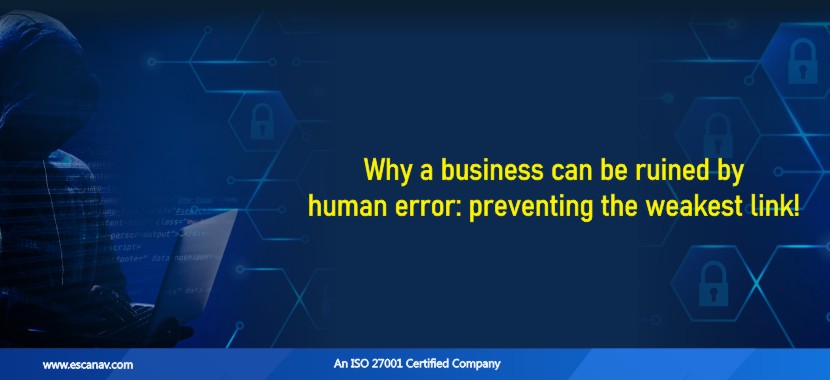- According to “The Global Risks Report 2022”, human errors are responsible for 95% of cybersecurity issues.
- As part of its safety measures, eScan Software highlights the measures that companies must take in order to ensure their security.
In the digital age, cybersecurity has become a top concern for businesses due to the potential harm that cyberattacks can do to their brand and financial standing. Ransomware attacks hit 71% of businesses in 2023, with an average payout of $4.35 million. Cybersecurity begins with employees, who are the most vulnerable entry points.
There is a clear picture of the impact of human error in cybersecurity based on statistics. It is estimated that 90% of cybersecurity breaches are caused by human error, according to the World Economic Forum’s ‘Global Risks Report 2022‘. Several real-life examples are available; one notable example was the 2017 Equifax breach, which exposed the personal information of over 143 million people after a single employee failed to implement a security patch. An example is the 2013 Target breach in the US, where hackers gained access through phishing emails sent to third-party vendors, ultimately compromising 41 million customer records. Because it establishes the potential severity of the penalties the organization may face, their response and monitoring of cyberattacks are crucial. Cyberattack response and monitoring are critical since they establish the potential severity of the consequences for the firm.
Human errors include using weak passwords, falling victim to phishing scams, and mishandling sensitive information, often leading to devastating consequences. There is no question that humans are more vulnerable to such intrusions and cyber attacks than other living species. These vulnerabilities are heavily influenced by psychological and behavioral factors. An optimism bias or overconfidence can lead to lax security practices due to cognitive biases. Additionally, a lack of awareness of potential threats is a significant risk factor. “Encourage employees and teach them about the consequences of not following security policies,” Dan Creed, CISO of Allegiant Air, said during the CPX Vegas conference roundtable. By manipulating individuals into divulging confidential information or taking actions that compromise security, social engineering exploits these vulnerabilities and is heavily used in phishing scams as well as new deepfake and voice scams.
The implementation of Zero Trust architectures and threat detection software is not the only way for companies to ensure they have a solid security posture, but the cybersecurity training that employees receive is also essential to prevent any type of cyber attack utilizing accessing the corporate network.
Ransomware attacks emphasize an employee’s importance even further, since these human errors are coupled with extortion to obtain large sums of money. Public extortion victims are increasing, with eScan’s 2024 Security Report reporting that there were more than 5000 victims of this type of attack in 2023, an increase of 90% over the previous year.
Cybersecurity measures recommended by eScan Software for building a solid protection in a company include:
- Prioritizing cybersecurity: The importance of cybersecurity measures in companies cannot be overstated. Cyber threats and their risks must be promoted, and training needs to be provided to ensure employees have a basic understanding of cybersecurity. In the majority of cases, cyber attacks are caused by human mistakes that can be avoided with even the most minimal training, such as falling for phishing emails, using weak passwords, or accidentally leaking information. Developing a culture of security within organizations, where cybersecurity is viewed as everyone’s responsibility, is also essential.
- Zero Trust strategy: A zero-trust model or trustless model is highly effective in preventing unauthorized access. When implementing a Zero Trust policy, unprotected devices are discovered and an automatic least privilege policy is applied, allowing only relevant personnel and systems access to this information.
- Incident response plan: The vulnerability of your organization to a cyber-threat is inevitable, so a consistent cyber-crisis response plan is essential. Employees know how to respond to possible incidents, enabling them to minimize damage and take quick action.
- Establishing unique and secure passwords: Employees should use complex passwords that are unique to themselves. The effectiveness of this initial security layer is dependent on its ability to prevent unauthorised access and safeguard confidential company information. Incorporate different letters, uppercase and lowercase letters, symbols and numbers into the password, as well as multi-factor authentication (MFA), regular password changes and enforcing a lockout policy after several failed attempts. A minimum length of between 14 and 16 characters is recommended.
- Technologies that make up for human weaknesses: Automated security measures cut down on the need for manual updates and checks, while security protocols like two-factor authentication offer an extra layer of safety. AI and machine learning are increasingly being used to identify and prevent human-related breaches by identifying patterns or behaviours unexpectedly indicative of risk, an imperative since AI tools are needed to capture such AI risks.
Managing cybersecurity in the future will require integrating advanced technology with an understanding of human psychology and behaviour in order to create human-centric solutions. There will need to be more sophisticated training programs for employees, possibly even utilizing simulations, while AI could become more capable of predicting human errors before they become breaches. As a result, we insist that companies combine technological solutions with cybersecurity training for their teams, along with preventive measures and a consistent response strategy.







